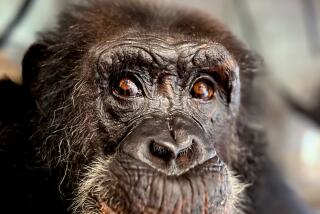Farmers Seeing Red Over Rare Monkeys
TANA RIVER RESERVE, Kenya — The future looks bright for the endangered red monkeys in the Tana River Primate Reserve. Prospects are less rosy, however, for their neighbors in the age-old conflict between animals and humans that festers along the banks of Kenya’s longest river.
More than 330 families are dependent on land inside the reserve, and many more live on its fringes. To ensure the survival of the 2,400 rare Red Colobus and Crested Mangabey monkeys in the reserve, the humans are being asked to pack their meager belongings and leave their ancestral land.
The Kenya Wildlife Society, which is implementing a $6.2-million World Bank-funded project to protect the primate reserve, says men and monkeys can no longer coexist. And so, a once-peaceful farming community whose members eke out a living growing bananas and corn on tiny plots of land is now divided.
Although 247 families have agreed to move in return for new houses and land, others are incensed and claim the Kenya Wildlife Society and the bank care more about monkeys than they do about humans. A third group of farmers finally decided they would like to move, but the project has no more money to finance them.
“We are against everything that has happened . . . we will never leave,” said an angry Seth Ablo, a 76-year-old who has farmed on the fertile land all his life. “The community was not informed about the project, and it [the land] was made into a reserve without the will of the people.”
Controversy has surrounded the 65-square-mile reserve since it was established in 1976. Poaching and banditry were rife. With the arrival of the Kenya Wildlife Society a decade ago, poaching has decreased, but Ablo and his friends resent their restrictions.
The reserve, 235 miles southeast of the Kenyan capital, Nairobi, is dotted with patches of dense forest in a dry savanna that offers farmers little oases of fertility in a region of semiarid scrubland. It is home to seven primate species as well as many kinds of birds, mammals and rare plants.
To protect the environment and the monkeys that swing through the tops of towering trees, the society has restricted the use of the land and prevented farmers from carving out bigger plots.
The farmers in the reserve will never be able to own the land.
Because of this, some are only too willing to move to new homesteads donated by the government where they have been promised 15 acres of land and new houses worth $6,329. In fact, they can’t move fast enough as tempers rise and threats of physical injury and witchcraft abound.
In February, several dozen chanting women angrily charged scientists working on the edge of the reserve, raising their skirts at them in a traditional gesture intended as a curse.
“The anti-project people are threatening our lives. When you stay around here, crocodiles are sent for you . . . that is part of the witchcraft,” said Omar Komora, who is planning to move. “If we stay here, we will be squatters for the rest of our lives.”
The lure of title deeds in a country where the price of owning land is beyond the reach of most has compensated for any sentimental attachment people like Komora had to their ancestral homes in the reserve.
The Kenya Wildlife Society says the conservation issue is clear--if the monkeys, which are found nowhere else on earth, are to survive, the people must go.
“If the two cannot coexist, something obviously has to be done,” said Richard Bagine, the society’s deputy director of research. “These creatures have no other alternative, but humans can move. If people stay here, the monkeys will be killed off.”
The land where the new houses are being built about 30 miles southeast of the reserve is ideal for farming, project officials say.
But the plan is proving to be another headache for the World Bank in Kenya where it is an object of frequent criticism.
The bank is being blamed by farmers opposed to the project for taking away their ancestral land, while pro-project farmers complain that relocation is taking too long.
“This component [relocating the farmers] represents the biggest problem . . . simply because KWS is finding it difficult to get consensus within the community about what should be done to conserve the reserve,” Richard Kaguamba, the bank’s environment specialist in Kenya, said.
“Some communities are being ostracized by others, and if people could move today, maybe that alienation would stop.”
The World Bank funding is supposed to end once the families have been relocated. What happens to the reserve after that is unclear.
Ultimately, the Kenya Wildlife Society would like to open the reserve to tourism, but that will take money the government does not have. At present, the dusty roads leading to the reserve can only be traveled with an armed escort because bandits still strike in this remote corner of Kenya.
More to Read
Sign up for Essential California
The most important California stories and recommendations in your inbox every morning.
You may occasionally receive promotional content from the Los Angeles Times.










